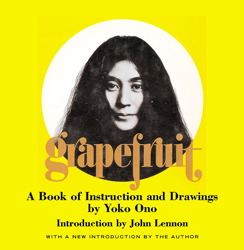Yoko Ono: Grapefruit: A Book of Instructions and Drawings (1964-) [EN, ES, PT]
Filed under artist publishing | Tags: · art, conceptual art, poetry

Grapefruit is an artist’s book written by Yoko Ono, originally published in 1964. It has become famous as an early example of conceptual art, containing a series of “event scores” that replace the physical work of art – the traditional stock-in-trade of artists – with instructions that an individual may, or may not, wish to enact.
Originally published by Wunternaum Press, Tokyo, 1964
English edition
With Introduction by John Lennon
Publisher Simon & Schuster, 1970/2000
S & S Edition
Wikipedia (EN)
Grapefruit: A Book of Instructions and Drawings by Yoko Ono (English, 1970/2000, 15 MB, updated on 2019-3-20)
Pomelo: Un libro de instrucciones de Yoko Ono (Spanish, trans. Pirí Lugones, 1970)
Grapefruit: O Livro de Instruções e Desenhos de Yoko Ono (Portuguese, trans. Giovanna Viana Martins and Mariana de Matos Moreira Barbosa, 2009)
Mary Jane Jacob, Michelle Grabner (eds.): The Studio Reader: On the Space of Artists (2010)
Filed under book | Tags: · art, painting, photography, sculpture

The image of a tortured genius working in near isolation has long dominated our conceptions of the artist’s studio. Examples abound: think Jackson Pollock dripping resin on a cicada carcass in his shed in the Hamptons. But times have changed; ever since Andy Warhol declared his art space a “factory,” artists have begun to envision themselves as the leaders of production teams, and their sense of what it means to be in the studio has altered just as dramatically as their practices.
The Studio Reader pulls back the curtain from the art world to reveal the real activities behind artistic production. What does it mean to be in the studio? What is the space of the studio in the artist’s practice? How do studios help artists envision their agency and, beyond that, their own lives? This forward-thinking anthology features an all-star array of contributors, ranging from Svetlana Alpers, Bruce Nauman, and Robert Storr to Daniel Buren, Carolee Schneemann, and Buzz Spector, each of whom locates the studio both spatially and conceptually—at the center of an art world that careens across institutions, markets, and disciplines. A companion for anyone engaged with the spectacular sites of art at its making, The Studio Reader reconsiders this crucial space as an actual way of being that illuminates our understanding of both artists and the world they inhabit.
Publisher University of Chicago Press, 2010
ISBN 0226389618, 9780226389615
390 pages
Hans-Ulrich Obrist: A Brief History of Curating (2008)
Filed under book | Tags: · art, conceptual art, contemporary art, curating, exhibition

11 interviews with curatorial pioneers.
This publication is dedicated to pioneering curators and presents a unique collection of interviews by Hans Ulrich Obrist: Anne d’Harnoncourt, Werner Hofman, Jean Leering, Franz Meyer, Seth Siegelaub, Walter Zanini, Johannes Cladders, Lucy Lippard, Walter Hopps, Pontus Hultén, and Harald Szeemann are gathered together in this volume.
The contributions map the development of the curatorial field, from early independent curating in the 1960s and 1970s and the experimental institutional programs developed in Europe and in the USA at this time, through Documenta and the development of biennales.
The book is part of the Documents series, co-published with Les presses du réel and dedicated to critical writings.
Colaboradores Hans-Ulrich Obrist, Lionel Bovier
Publisher JRP / Ringier, 2008
Volume 3 of Documents Series
ISBN 390582955X, 9783905829556
302 pages
Download (removed on 2014-1-7 upon request of the distributor)
Comment (0)
